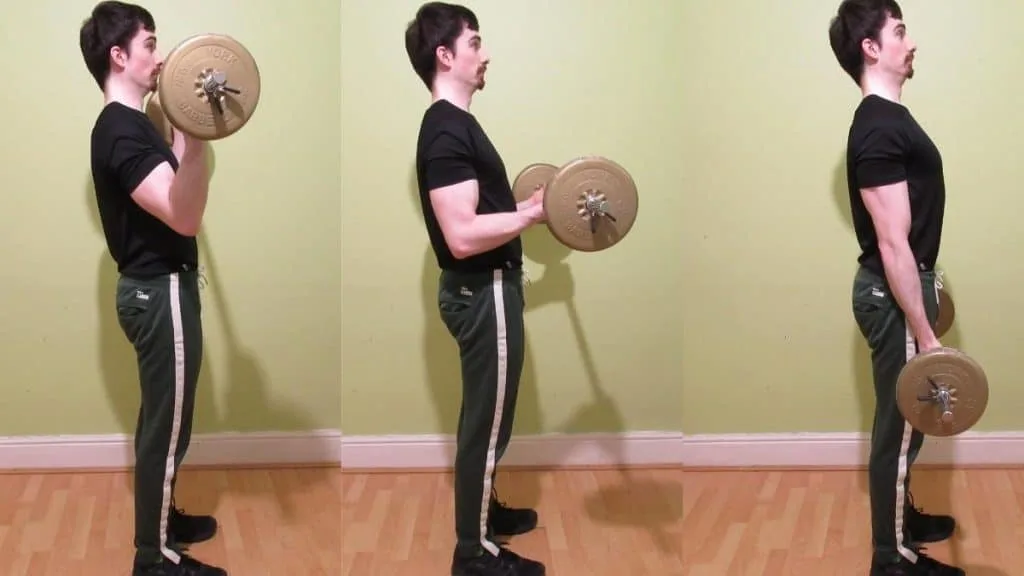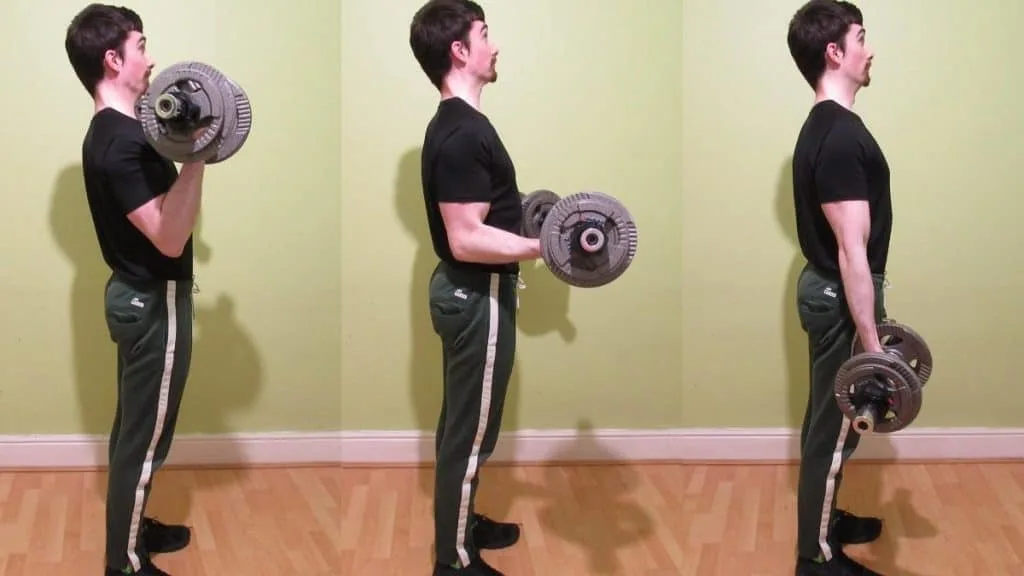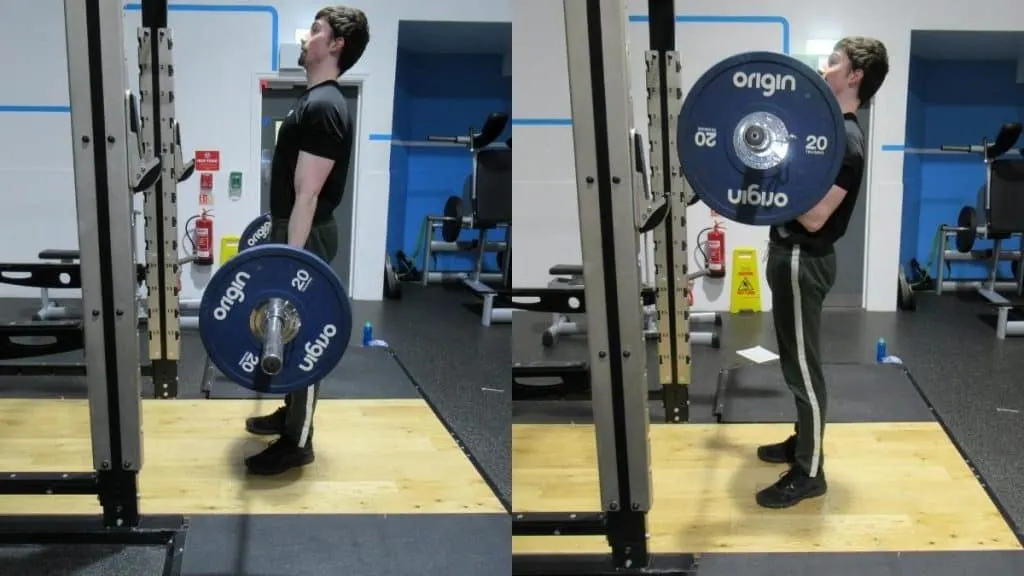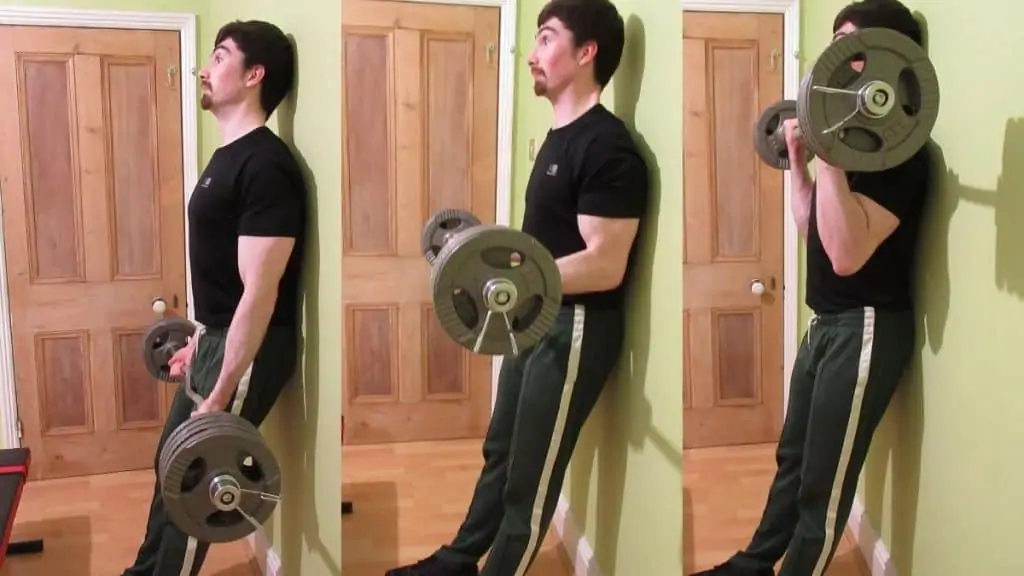Negative curls overload the bicep muscles and make them grow because they enable you to lift around 40% more resistance than on regular curls. As such, they’re an excellent exercise for building more mass or breaking through a strength-gaining plateau.
Related Exercise: Static curls
Negative curl exercise details
- Main Muscles: Biceps brachii
- Secondary Muscles: Brachialis, brachioradialis, forearm flexors
- Exercise Type: Strength
- Exercise Mechanics: Isolation
- Difficulty Level: Intermediate
- Equipment Needed: Barbell, weight plates
How to perform negative bicep curls
- Calculate how much weight you can curl for 6-8 clean reps, then add 40% more resistance than that figure to a barbell.
- Grab the barbell with a shoulder-width underhand grip.
- Curl the bar toward your chest with the help of your training partner. You can also use your hips and legs to generate some momentum.
- Contract your biceps at the top of the rep.
- Slowly lower the weight by yourself over a 3-5 second duration until your elbows are completely locked out.
- Perform 3-5 sets of 6-8 reps in total.
Negative bicep exercises
Give these eccentric bicep exercises a try if you have plateaued on regular curls or if you want to give your biceps more tension without actually performing any extra sets.
Negative barbell curl

The negative barbell curl is the most convenient type of negative curl because you can load a precise amount of weight onto a barbell, which is great for progressive overload. Similarly, barbells enable you to lift more weight than any other kind of training tool.
You can also check out our guide to the proper barbell curl form if you need a refresher on the optimal technique. But essentially, you want to curl a weight—with the help of a training partner—to your chest as efficiently as possible.
Ideally, you’d use a strict lifting form, but if you need to use a bit of momentum to get the weight moving, that’s fine too (but no half curls). This exercise is all about the negative portion of the rep anyway.
Once your biceps are contracted at the top part of the rep, give your gym buddy a second to take their hands away and then lower the weight slowly—by yourself—over a 3-5 second period until your elbows are fully locked out.
Dumbbell negative curls

If you have muscular imbalances, then negative bicep curls are a great variation to try. The downside, of course, is that you won’t be able to overload your biceps with as much resistance as the barbell version.
So you need to make a choice. Do you want to maximize your bicep size or symmetry?
Of course, you can do both variations (ideally during different workouts). But if you’re trying to bulk up, your best bet is to stick to the barbell version so that you can overload your biceps with as much weight as possible.
On the other hand, if you already have a solid foundation of mass, then you can work on the proportion of your arms by doing the dumbbell negative bicep curl instead.
While you can also do this version with a partner, it can be hard for them to assist with two dumbbells. So you’re best off using a normal weight but really slowing down the negative (5-8 seconds) to compensate for the lighter resistance.
So while you might not be lifting as much weight, you’re still getting plenty of tension.
Power rack negative curls

This is one of the most effective and, might I add, underrated negative bicep exercises that you can do for mass. You’ll still need a training partner, but they don’t need to be particularly strong.
Essentially, you’re going to add 40% to your regular curl weight and place it at shoulder height in a squat rack. Then, you’re going to unrack the bar and lower it over a 5-8 second period with your biceps.
Now, here’s where your gym helper comes in handy.
You’re both going to lift the bar back into the rack by holding one end each. Then, take a few seconds of rest and perform another rep. Repeat the process until you’ve done 5-8 total reps.
Don’t worry about the re-racking of the bar interfering with your sets. You’re only holding half the weight for a couple of seconds, and besides, you don’t need strength to lift the full weight; we’re just performing negatives here.
EZ negative curls

If lifting a straight bar puts too much pressure on your wrists, then you can do negative standing EZ bar curls instead.
The technique is exactly the same as it is for standard negative bicep curls. The only minor difference is that you’re using a semi-supinated grip with the EZ version, which will increase the activation of your brachialis and brachioradialis muscles at the expense of your biceps (to be sure, your biceps are still getting plenty of work).
You can also do a negative chain curl to overload your biceps at the top part of the rep so that you don’t have any weak links in your curl.
Conclusion: How to maximize the negative bicep curl
The two most effective ways to make use of these negative bicep exercises are for building mass or for burning out your biceps at the end of a workout.
If you’re doing negative curls to gain size, perform them at the beginning of your session with 40% more weight than you’d normally curl with strict form.
On the other hand, if you’re performing the negative curl to finish off your biceps, use a lighter weight and curl normally (no swinging or training partner assistance). However, slow down the negatives as much as possible to compensate for the lighter resistance. These extended negatives will also create a more intense muscle burn and recruit the remaining fibers to stimulate maximum growth.

